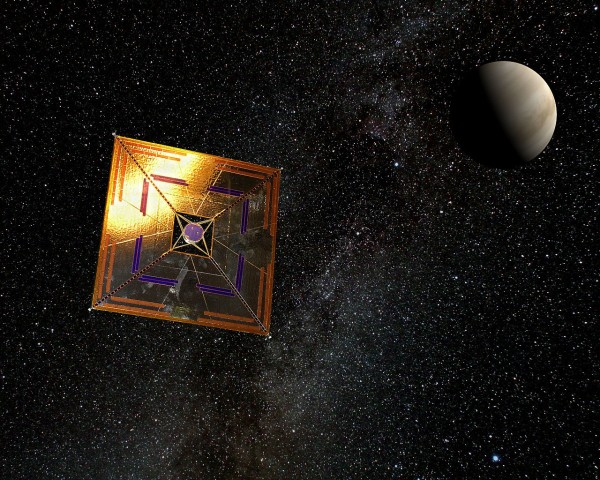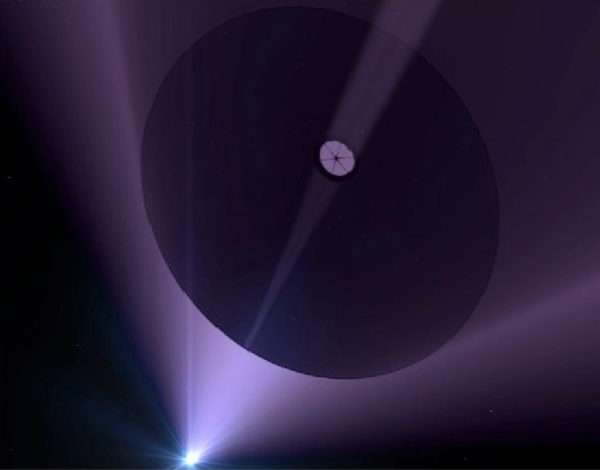"Greatness is not in were we stand, but in what direction we are moving. We must sail sometimes with the wind, and sometimes against it - but sail we must. And not drift, nor lie at anchor." –Oliver Wendell Holmes
It's long been a dream of humanity to travel interplanetary distances at great speeds, or to make it to another star system within a human lifetime. Until recently, technologies to get us there -- antimatter propulsion, wormholes or warp drive -- have all been composed of physically unrealistic solutions. But recent developments in laser technology make directed energy propulsion a feasible solution.
 Image credit: Wikimedia Commons user Andrzej Mirecki, under a c.c.a.-s.a.-3.0 license, of the related solar sail concept IKAROS mission.
Image credit: Wikimedia Commons user Andrzej Mirecki, under a c.c.a.-s.a.-3.0 license, of the related solar sail concept IKAROS mission.
By building a giant laser array in space and developing a new type of solar sail that reflects the laser light with incredible efficiency, a laser sail, this propulsion system is scalable to arbitrarily large powers. There are many technical obstacles to be overcome, and so it's unlikely we'll see the fruit of this anytime in the next few decades (despite the promises of some), but this may well be the technology that takes us to the stars in the coming centuries.
 Artistic rendition of a laser-driven sail. Image credit: Adrian Mann, via http://www.deepspace.ucsb.edu/projects/directed-energy-interstellar-pre….
Artistic rendition of a laser-driven sail. Image credit: Adrian Mann, via http://www.deepspace.ucsb.edu/projects/directed-energy-interstellar-pre….
Go read the whole story over on Forbes, but don't get your hopes up too high, too fast!

The obvious solution to the lack of deceleration problem - IF we were seriously intending to use this technology repetitively, for example to set up a Mars-Earth system - would be to use chemical rockets to propel a remote controlled laser facility to Mars or some other destination spot, and then operate the two-laser system in the classic 'accelerate halfway/flip/decelerate rest of the way' mode.
Gravity assists can also decelerate a probe, as can planetary atmospheric braking, though obviously neither is up to the challenge of taking something from (relatively) 26% of light speed down to a (relatively) dead stop.
We will be quicker to the stars than from scienceblogs to Forbes.
The power/thrust ratio is really high with a sail. Momentum of a photon is mc, whereas energy is m*c**2. So the energy efficiency of such an approach is really poor, until the objects speed starts approaching a decent fraction of C.
We would do better with PV or nuclear powering an ion drive -at least for within the solar system stuff. Then propellant rather than energy becomes the limiting factor.
I could maybe maybe just see this approach working if we can build and communicate with nano-sized space vehicles. Anything like the sizes we are currently used to requires massive drivers. Just like in electronics, miniaturization seems to be the most promising way forward.
My problem with Daedelus (or any interstellar ramjet system) was that you have the scoop intercepting high-E particles for thrust and shielding the contents of the ship from same on the way out.
Slowing down, you have no big dish because you have to face the other way to eject and decelerate the craft, meaning no collection of material at high-E and no protection of the contents of the ship.
I've always thought solar sails made better parachutes than propulsion systems. Spacecraft can accelerated to high speed via a linear accelerator built around an airless planet or moon and flung off in the direction of a target star system. Once the probe gets through the heliopause of the destination system, the solar sail can be deployed to decelerate.
In so doing the probe doesn't need to carry the massive amount of fuel required to accelerate or decelerate, the solar sail is somewhat protected from damage while in interstellar space, and the transit time is cut because there is no great long acceleration/deceleration phases where the probe isn't traveling at top speed.
This has now been mentioned on Your Daily Dish.
http://www.yourdailydish.com/nasas-propulsion-theory-suggests-travel-ma…
You *CAN* steer a sail, by tacking.
You *CAN* decelerate a sail. Detach an outer ring of the sail, and turn on the laser again. The laser light hitting the outer ring is reflected back at the other side of the payload sail. If the numbers are right, the light hitting from the outer ring will exert more force than the light hitting direct from the laser; and the payload will decelerate.
Credit for that idea goes to the late Dr. Robert Forward, who wrote about it in his novel _Rocheworld_ (as well as in published papers).
I think the maths has gone a little wrong here. You state that a laser in the gigawatt range would require an area of 100 square km. This implies a power of just 10 watts per square meter - massively below where we are at present - in fact by about a factor of a thousand at least. So actually the area required would be a rather small fraction of a square km, maybe just 100m by 100m - quite doable.